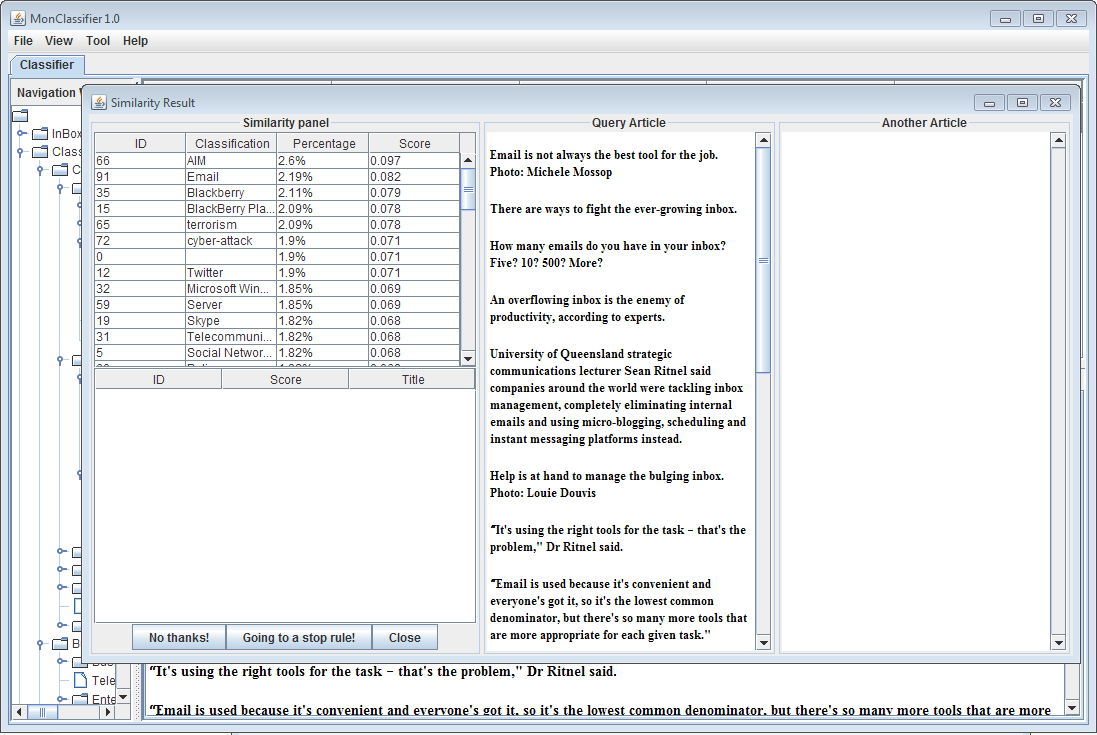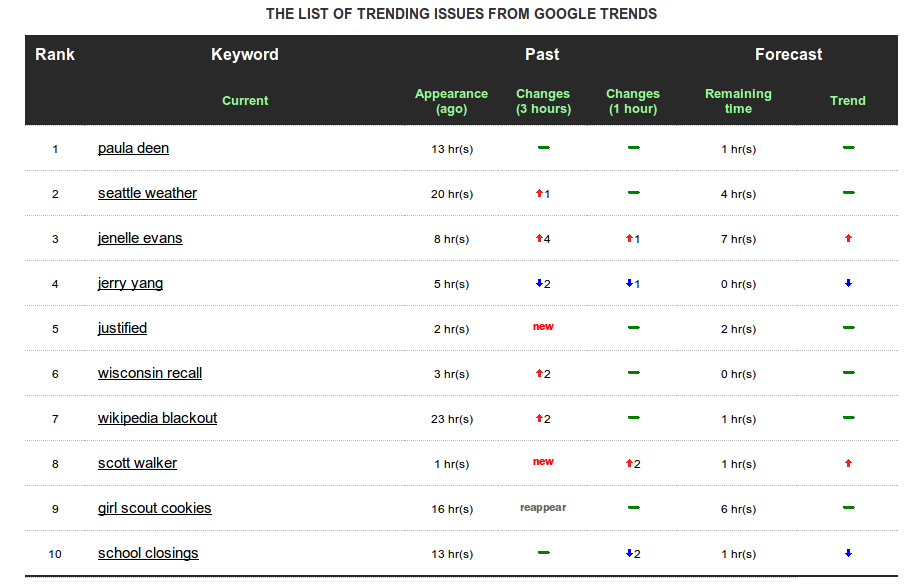RDR(MCRDR) Framework
DESCRIPTIONS
To get the source code or developer manual, please contact us
This system is the RDR framework.Adding a new classification approach to the RDR framework should be, in most of the cases for which this software was designed, a relatively simple process. Included in the distribution of this package are two default classification methods, Single Classification Ripple Down Rules (SCRDR) and Multiple Classification Ripple Down Rules (MCRDR). To assist future developers in understanding how this system is designed this manual will
attempt to explain in some detail how MCRDR was implemented within this framework.
If you would like to have a look at this system, please read the following documents
RDR Framework manual: PDF
Java Docs: Link

Publications
- Compton, P., Peters, L., Edwards, G., & Lavers, T. G. (2006). Experience with ripple-down rules. Knowledge-Based Systems, 19(5), 356-362.DOWNLOAD : [[Paper Link]]
- Kang, B., Compton, P., & Preston, P. (1995, February). Multiple classification ripple down rules: evaluation and possibilities. In The 9th Knowledge Acquisition for Knowledge Based Systems Workshop.DOWNLOAD : [[Paper Link]]
- Bindoff, I., Tenni, P., Kang, B., & Peterson, G. (2006). Intelligent decision support for medication review. Advances in Knowledge Acquisition and Management, 120-131.DOWNLOAD : [[Paper Link]]
- Bindoff, I., Kang, B., Ling, T., Tenni, P., & Peterson, G. (2007). Applying MCRDR to a multidisciplinary domain. AI 2007: Advances in Artificial Intelligence, 519-528.DOWNLOAD : [[Paper Link]]
- Bindoff, I., & Kang, B. (2011). Applying multiple classification ripple round rules to a complex configuration task. AI 2011: Advances in Artificial Intelligence, 481-490.DOWNLOAD : [[Paper Link]]
- Yoon, H., Han, S. C., Kang, B. H., & Park, S. B. (2012). V&V to Use Agile Approach in ES Development: Why RDR Works for Expert System Developments!. Computer Applications for Software Engineering, Disaster Recovery, and Business Continuity, 113-120.DOWNLOAD : [[Paper Link]]
MCRDR(RDR) Document Classifier
DESCRIPTIONS
To get the source code, please contact us
Our research focuses on the information management systems of the dynamic World Wide Web. Many individual web pages, such as news portals, provide periodic information and public announcements from various organizations. Pushing methods include semantic web methods or RSS (Really Simple Syndication), which is one of the related approaches to monitoring this type of information. Information filtering and classification of collected information are integral to information management systems because people have to locate and archive for the future, as well as for the present. One of the major problems in applying the current information filtering or classification approaches to this dynamic information is that the classification or filtering of knowledge is not static, so the system must be able to manage the change of knowledge in real time. Previous studies have proven that while the current approaches can handle pre- sampled information very well, the maintenance issue is not well addressed. i-Web has been developed to locate the new information from the target (registered) Web sites and Multiple Classification Ripple Down Rules, the knowledge acquisition method, is applied to maintain the information classification knowledge in this system. The MCRDR-based document classification enables domain users to elicit their domain knowledge incrementally and revise their knowledge base (KB). They may then reclassify documents according to context changes. Our experiment results show the MCRDR document classifier performs these tasks successfully in the real world.

Publications
- Kim, Y. S., Park, S. S., Deards, E., & Kang, B. H. (2004, April). Adaptive web document classification with MCRDR. In Information Technology: Coding and Computing, 2004. Proceedings. ITCC 2004. International Conference on (Vol. 1, pp. 476-480). IEEE.DOWNLOAD : [[Paper Link]]
- Park, S. S., Kim, Y. S., & Kang, B. H. (2004). Web document classification: Managing context change. In IADIS International Conference WWW/Internet (pp. 143-151).DOWNLOAD : [[Paper Link]]
- Park, S. S., Kim, Y. S., & Kang, B. H. (2004). Personalized web document classification using MCRDR (Doctoral dissertation, School of Computing, Unviersity of Tasmania).DOWNLOAD : [[Paper Link]]
Social Issue Forecasting System
DESCRIPTIONS
To get the source code, please contact us
Recently, it have shown a spectacular surge in popularity of web services, such as social networking sites, trends services. For this reason, the life cycles of social issues have been changed a lot. Since there are various types of the lifecycle of social issues, it may be useful to predict/figure out how the trend of a certain issue will be shown. By predicting the trend of social issues, users are able to the importance of a social issues before it happens.Trends Forecast will support this for all users.
If you would like to have a look at this system, please go to the following website
http://www.trendsforecast.net
Publications
- Han, S. C., & Kang, B. H. (2012, June). Identifying the Relevance of Social Issues to a Target. In Web Services (ICWS), 2012 IEEE 19th International Conference on (pp. 666-667). IEEE.DOWNLOAD : [[Paper Link]]
- Han, S., & Chung, H. (2012). Social Issue Gives You an Opportunity: Discovering the Personalised Relevance of Social Issues. Knowledge Management and Acquisition for Intelligent Systems, 272-284.DOWNLOAD : [[Paper Link]]
- Han, S. C., Chung, H., & Kang, B. H. (2012). It is time to prepare for the future: Forecasting Social Trends. Computer Applications for Database, Education, and Ubiquitous Computing, 325-331.DOWNLOAD : [[Paper Link]]
 Open
Open
 Close
Close
- Rank : It indicates each rank of the trending keywords
- Title : It indicates the list of top 10 trending keywords for now.
- Appearance : It indicates when time they first appeared
- Changes : It indicates the ranking changes in a hour and three hours.
- Remaining time : It indicates how much hours each trending keyword remain in the list of top 10 trending issues.
- Trend : It indicates whether the rank rise or fall in next hour.
Trends Forecast supports displaying each trending issues status, when the user click each keyword in the table.

Left/Graph
- X value : It indicates "time". (e.g. From the graph, 1 means a hour ago)
- Y value : It indicates "ranking"
Right/Table
- It indicates each top 10 trending issues. It is ordered by rank.
Top/Red box
- Users can download and print the graph.
Web Monitoring System
DESCRIPTIONS
To get the source code, please contact us
Our research focuses on web information management for people who want to monitor and use the World Wide Web information, as their information resource. Web information is mainly open to the public and search engines are widely used, although there are complaints about the large amount of irrelevant information. Some web technology research focuses on promptness of changed information and relevance to users. Most web search engines do not fully satisfy these two requirements in general because they try to cover all web sites and users together. The aim of Web monitoring research is to overcome these problems. Web monitoring systems check predefined web pages and prompt users when there are changes in these pages. This research focuses on the management of newly uploaded information in target web sites. In a web monitoring system, the system should cover various different types of web pages, as well as personal aspects. This system achieves these tasks by integrating the first and third modules. In addition to web monitoring functions, the second module provides the information management functionality in the user’s local storage.
Publications
- Park, S. S., Kim, S. K., & Kang, B. H. (2003). Web information management system: Personalization and generalization. In the IADIS International Conference WWW/Internet (Vol. 2003).DOWNLOAD : [[Paper Link]]
- Kim, Y. S., Park, S. S., Deards, E., & Kang, B. H. (2004, April). Adaptive web document classification with MCRDR. In Information Technology: Coding and Computing, 2004. Proceedings. ITCC 2004. International Conference on (Vol. 1, pp. 476-480). IEEE.DOWNLOAD : [[Paper Link]]
- Park, S. S., Kim, Y. S., & Kang, B. H. (2004). Web document classification: Managing context change. In IADIS International Conference WWW/Internet (pp. 143-151).DOWNLOAD : [[Paper Link]]
- Park, S. S., Kim, Y. S., & Kang, B. H. (2004). Personalized web document classification using MCRDR (Doctoral dissertation, School of Computing, Unviersity of Tasmania).DOWNLOAD : [[Paper Link]]

